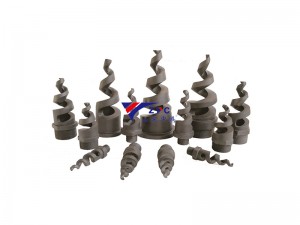In the grand picture of industrial production, there are always some seemingly tiny components silently undertaking critical missions. The silicon carbide desulfurization nozzle is such a “behind the scenes hero” – it hides in the desulfurization tower of power plants and steel plants, day after day “cleaning” industrial flue gas, intercepting harmful sulfur dioxide before emission. What is the special feature of this precision device made of silicon carbide material?
1、 Why silicon carbide? The ‘hard bones’ in the material
To understand the advantages ofsilicon carbide desulfurization nozzles, we need to start with their “constitution”. Silicon carbide is an artificially synthesized inorganic material, with atoms bonded by extremely strong covalent bonds to form a stable structure similar to diamond. This structure endows it with three “superpowers”:
Corrosion resistant: Industrial flue gas is mixed with corrosive substances such as acid mist and limestone slurry, and ordinary metal nozzles will soon be corroded and riddled with holes. Silicon carbide has a much higher resistance to acid and alkali than metals, and can maintain structural integrity even after long-term immersion in highly corrosive environments.
Can withstand high temperatures: The flue gas temperature inside the desulfurization tower often reaches hundreds of degrees Celsius, and sometimes there may be severe temperature differences due to equipment start-up and shutdown. The thermal stability of silicon carbide is extremely strong, and it is not easy to crack even in the event of instantaneous high temperature impact. It is still reliable under extreme high temperature conditions.
Can withstand wear and tear: When the high-speed flowing desulfurization slurry passes through the nozzle, it will continuously erode the inner wall. The hardness of silicon carbide is second only to diamond, and it can easily resist this kind of wear. Its service life is several times that of ordinary plastic or metal nozzles.

2、 Not only ‘durable’, but also a ‘booster’ for desulfurization efficiency
The value of silicon carbide desulfurization nozzles goes far beyond “longevity”. Its design hides a mystery: the internal spiral channels allow the desulfurization slurry to continuously mix and collide in the flow, ultimately atomizing into fine and uniform droplets – the larger the contact area between these droplets and the flue gas, the higher the efficiency of sulfur dioxide absorption.
More importantly, it is not easily clogged. Small particles are inevitably mixed into industrial slurries, and the narrow channels of ordinary nozzles are easily blocked, resulting in uneven spraying and reduced desulfurization efficiency. The flow channel design of the silicon carbide nozzle is spacious, allowing particles to pass smoothly, greatly reducing downtime and maintenance caused by blockage.
3、 The ‘essential choice’ under environmental protection policies
With increasingly strict environmental standards, enterprises have higher requirements for desulfurization equipment. For example, the concentration limit of sulfur dioxide in the flue gas emitted by power plants has been significantly tightened. This means that the desulfurization system must be more efficient and stable – and the performance of the nozzle directly affects the final purification effect.
Although the initial procurement cost of silicon carbide desulfurization nozzles is higher than that of ordinary nozzles, they are actually more economical in the long run. Its service life is several times longer than that of plastic nozzles, which can significantly reduce replacement frequency and downtime losses. For enterprises pursuing sustainable production, the characteristic of “one-time investment, long-term worry free” is particularly valuable.
4、 Not just desulfurization, future applications are visible
In addition to industrial flue gas treatment, the potential of silicon carbide materials is emerging in more fields. Its high temperature resistance and radiation resistance make it stand out in high-end fields such as nuclear energy and aerospace; In the new energy industry, it is also used in high-temperature sintering equipment for lithium battery materials. As a desulfurization nozzle, it remains an indispensable part of current environmental governance.
This’ small component ‘hidden in the desulfurization tower is actually a bridge between industrial civilization and ecological protection. It uses the wisdom of materials science to make it possible for industrial production to coexist with blue skies and white clouds – perhaps the best interpretation of technology protecting the environment.
Post time: Aug-04-2025